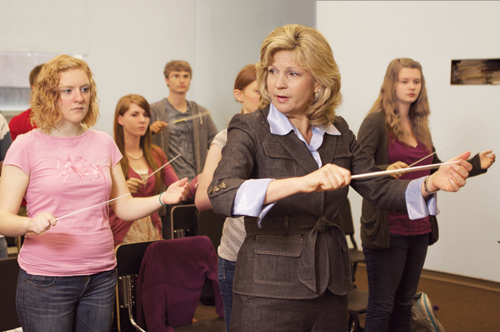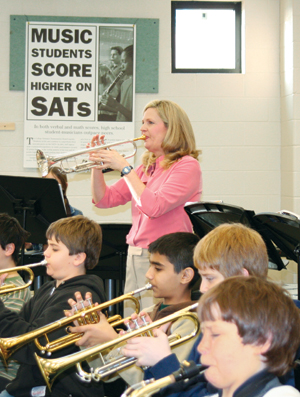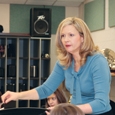After nearly three decades of teaching middle school bands, Mary Land has taken her direct, no-nonsense approach to the college level. She says, “As a young teacher I spent every spare moment observing successful teachers and inviting these master teachers into my band room to critique my teaching. We are very generous in the music education field; we share ideas about pedagogy, literature, technology, and everything associated with our subject. My teaching style and strategy is a blend of personal experience and professional collaboration with colleagues.” She now shares the lessons learned with the next generation of directors. Although the age of her students has changed, the skills for smooth rehearsals and efficient teaching remain much the same. She recently talked about some of the most common difficulties facing young teachers.

Interacting with students
It is an enormous adjustment for young teachers to flip from the role of student to that of teacher. New teachers are younger than most of the faculty and in high schools there is very little difference in age between them and the older students. They should first clearly establish a division between them and their students. Many young teachers talk to students casually with such terms as “you guys” or “y’all.” It will help them appear more professional to use the term students, as in “Students, we will start at letter A.” Another option is the even more formal ladies and gentlemen.
It doesn’t hurt for a young teacher to show interest in other student activities, however. If they invite you to a soccer match, go to it. They wouldn’t ask if it was not important to them.
 Provide Examples
Provide Examples
Teachers should provide many opportunities for students to hear what music sounds like. As students come into class, play a recording of the work that will be rehearsed that day. Many young teachers do not perform examples for students on their primary instrument, but this is an important way to explain how to play the music. If the flutes have a difficult part but the director is a trumpet player, just play it on the trumpet to model it for them. Novice directors should also pay attention to see whether the way they conduct looks like the way they want the music to sound.
I also did a tremendous amount of recording. I used Garage Band on an iPad and often recorded and played back music. The device is small so students did not realize when it was recording. At a subsequent rehearsal, I might say, “did you hear letter J yesterday? How can we fix this?” They listened to the recording and then went back to play it correctly and record it again.
Competition and Motivation
It is so important to have goals and personal standards. Let students feel success even if it is just making four measures sound great. Motivation comes from the podium. Students will not care about what they are doing until they know that the director cares about them and how they play. When I express how great they played, that feeling transfers to students. Students have to experience how it felt to sound so good. Then they will want to work to achieve that level again.
I also promoted competition in my middle school band so students tried to be the best in each section. I never gave bribes; the reward was being the best. In beginning band students sat in the order that they passed certain music, regardless of the instrument section. They might sit in a different order almost every class based on how far they had advanced in the book. Students who were less advanced sat in the front where they could receive more help, and the overachievers sat in the back. It became a status symbol for the beginners. At concerts we used traditional seating and sat in order of achievement. Those who had passed the most exercises in the book sat first chair.
Competition also provides motivation to practice. Students want instant gratification in almost everything they do and learning to play a musical instrument does not happen instantly. I have found that everybody cheats on practice records, even parents. I still believe in practice records, but students have to want to improve and master something. I have always demanded that to pass off a portion of the book, it has to be flawless. Students play exercises with a metronome or an accompaniment CD. It must be the correct tempo and in tune, or they do not pass.
Keep Everyone Involved
At the end of every school year I gave students an anonymous survey about what they enjoyed and did not like about band. When asked how they would like the class to be run differently, they always asked if they could start music at the beginning and play straight through until the end. Students don’t like to stop and wait while the director works out a problem with one section. To keep students engaged, work on chunks of the music with everybody playing. If there is a section where the trombones struggle with a specific phrase, write that phrase out for everybody in the band. The trombones learn and fix the phrase, and everybody else participates and learns it too.
Before introducing my sixth and seventh grade bands to a piece like Joy by Frank Ticheli, I would write a lead sheet with tricky main themes or maybe a key counter melody. I numbered the key passages and passed the sheet out, so they first mastered the parts on the lead sheet before getting the full music.
Sometimes I made a lead sheet that was exactly the same number of measures as the piece. I would put matching melodies or key themes at rehearsal numbers. If we reached letter D and the trombones were struggling, I would tell everybody in the band to go to letter D on the lead sheet. That way the percussion or saxophone sections had something to play too and were not bored or misbehaving while I taught the trombones. Everyone worked together. It is a little more work, but how cool is it for the tubas to learn a flute obbligato section? This also allows students from different sections to practice together. I often might hear a tuba player practicing a part with a flute-playing friend after school. This also lends flexibility for concerts. For example, if the trombones have yet to master a part, you can have the saxophones play the melody from the lead sheet.
I think young teachers have a good knowledge of music and know fingerings and rhythms. However, they do not know how to set a routine to move through a lesson and keep the pace. If students get bored, they drop out. Keep them engaged.
 Classroom Management
Classroom Management
Directors should have a plan to manage classes. My students had set procedures for entering the room. There was a door for entering and a door for exiting. As mentioned previously, I often had music playing as they entered, frequently a piece they were going to play that day. As part of lesson preparation, I would make a CD of everything we were currently playing. Students were taught to take their seats immediately and finger their part while looking at the music. We sometimes did not play a work straight through until just before the concert. This practice gave students a sense of the flow of the piece as they listened to it from beginning to end.
Another option as students enter the class is solfege practice. Beginning teachers often do not do this and are uncomfortable singing in front of a goup. I did not figure out how valuable it is until I had been teaching for a long time. Find a groove CD with a rhythm and a pitch, and as students enter practice with call and response. The director sings, and students sing it back. Once everybody is in their seats, the teacher plays a line, and students play it back. The director could also sing, and they respond on their instruments. From the moment students come into the room, they are involved, sit down, and are settled.
On other days, I put up a PowerPoint of the lesson plan. Young students are always a bit chatty, but I emphasized from the beginning that “we all play together or we don’t play at all.” This meant that they did not come in and play their own warmup. Older students know how to warm up, but middle school students just play non-musical sounds, which should be avoided. Once they were seated and had a moment to read the plan, I stepped up on the podium and signaled everybody to stand. I did not say a word but waited until everyone was standing and silent. This provided a visible sign that class was ready to begin. When everyone was focused, I told them to sit and began rehearsal.
This is a civilized way to start. Convey to students from the beginning that music is a cultured, sophisticated, and dignified activity. Do not yell and scream for attention. This approach has worked even with younger students.
When speaking to the group, use a voice with strong volume. Often young teachers try to talk over student conversations. I just stop and look at them until they get the hint and become silent. I never yell but they have to stop talking.
To keep students organized, I used three-ring binders that held everything they received, including music. With young students most music is one page. Have students place music on the right side and the lead sheet on the left, so they can easily go back and forth. The binder works far better than a music folder. Even notes to parents should go into the binder so they make it home instead of ending up on the floor.
Difficult Students
I have had the best success with problem students when I deal with them on a one-on-one basis. One or two students can disrupt the class for everyone, and directors cannot ignore them. Try to figure out the best way to handle them. One approach is to call on them in class and ask them to play something, but that may just embarrass them and cause more trouble. I never wanted to embarrass a student in front of his friends because it usually leads to retaliation. I think every teacher has a student who is a pain in the neck. Each one is a problem for different reason. There may be a terrible situation at home that you know nothing about. I sometimes sent a student to my office, and we talked privately after class. Take the time to speak with them personally, but be sure to act like an adult and do not stoop to the student’s level.
Every school has a discipline plan, and new ones seem to roll out yearly to cure all problems. These plans usually have little relationship to problems in music classes. I made my own versions: little note pads that had carbon copies and check boxes that identified the problem. Student who misbehaved would get a marked sheet to take home, and I would keep a carbon copy for reference. A parent signed the form, and if it came back signed the next day, that was the end of the discipline. If it didn’t come back in a couple of days, I would take the problem further up the discipline chain. The carbon copies helped me notice patterns of behavior. The rest of the class has to see that someone is being punished. If they see someone slip by without consequences, class discipline suffers.
Specific Instruction
One of my rules is that when you stop a group, there should be a specific reason. To deal with a problem, give precise instruction that teaches students how to resolve the difficulty themselves. For example, if middle school saxophones are flat, I use the phrase “you need to hide in each other’s sound.” This encouarages them to listen carefully and bury themselves into a pitch that is in tune. To teach this, I tune the first chair saxophone with a tuner. Now, the first saxophone is in tune, and the second player tries to match the lead player’s sound and then the next and so on. They have to figure it out on their own.
I like to use a motto or phrase when teaching young students because I have found it helps them remember. If you tell young students they are flat or sharp, they may not know what that means. I relate it to a pencil sharpener. If a pencil is sharp, pull it out of the sharpener. If the pencil is flat, push it into the sharpener. I also say that if the note is below the pitch, it is lower like a flat tire.
Whenever students will not play softly enough, I tell them any band can play loudly, but only the best bands can truly play piano. I also explain that if 70 students have a section marked piano, but only a few truly play that way, it will not sound soft. Unlike other disciplines, 100% of the participants have to follow the rules in order for it to be effective. On soft phrases, you have to hear others more than yourself.
Legato is another difficult concept to convey. Young students tend to play notes in a very separated way, so each note is its own entity. I use silly analogies to fix the problem. I will say “we are going to play a piece that calls for a very connected sound. Play this piece as if you are holding a kitten and petting it in a smooth way.” I also do a lot of singing. Students who learn to solfege through their music tend to play more musically because they learn to connect the notes. For sections that are legato but not completely slurred, I tell students that each note should touch each other. In a marcato section tell students that none of the notes can touch.
Warmups
I always use a warmup with everyone from beginners to college students. I often begin with concert F; in the key of Bb that is my so. I usually start with my first chair clarinet, or another student who knows how to play in tune. I use a tuner as a reference to get one person beautifully in tune. The clarinetist plays the concert F and everybody sings. Then the brass buzz while everyone else sings. Next the woodwinds play it as a whole note, and the brass buzz. Drop down to concert Bb, and ask the woodwinds to play and brass to buzz. This goes back and forth and is followed by an exercise with the brass playing instead of buzzing.
Another warm-up option is to play a pitch, sustain it, and then point at one section to continue sustaining the note while everyone else drops out. They listen to the note, and then when the director bring the hands up, it indicates that it is time for everybody else to come in. Continue the warmup and isolate different sections in the band.
A warmup should center on what is planned for that day. If the piece is in Eb major, then use an Eb concert scale in the warmup. If there will be work on a difficult articulated pattern, include those rhythms in a call-and-response. For example, the director might play a pattern on the trumpet and have the band play it back. If there is a rhythm that is particularly difficult, give students a rhythm card and have them all play it. I try to mix up the warmups to keep students on the edge of their seats. I never want to get things in a rut.
I visit a lot of band rooms to evaluate student teachers. Some walk in and mindlessly have students play a warmup Bb scale. There is no attempt to assess intonation or tone quality. Nothing is addressed. There has to be a reason for the warmup that you use on a particular day. It is fun to throw things out at students before they realize that it is part of the music for that day’s rehearsal. Then they are excited when the light goes on, and they understand the reason for that day’s warmup.
In general, talk less and play more. Have a plan for each lesson and make sure that each element of the rehearsal has a purpose. I feel extremely fortunate to have come full circle. During my long career as a middle school band director I nurtured and guided many student teachers and music education college students through their practicum experiences. Now I am heavily involved in teacher preparation from the very beginning of the music education process. I am committed to providing the highest-quality education for my students as they prepare to step into the rewarding and challenging career of music education.
* * *
Other Mistakes
• Start on time. When the bell rings, some new teachers are still in the office. Stand at the door when students enter the room and greet them. Start the class on time. If there is a tardy bell, use that as the time to start class.
• Stay focused on specific tasks. When I step on the podium, I am here to work. Stay on task and do not ask about their weekend. Have a plan and be ready to go.
• Speak assertively. This doesn’t mean to scare students but be very clear with directions.
• No false starts. Don’t bring your hands up to conduct and then start talking again. When you bring your hands up, play. At a performance, do no count the band off. Position, breathe, and go.
• Start teaching. Many beginning teachers begin classes with announcements. This leads to questions and wasted time. Save announcements until a brief break in the middle of rehearsal.
• Stay organized. Keep all equipment for teaching at the podium. I had a workstation made from containers with little drawers that were designed to hold nails and tools. I attached several to the wall behind my podium to keep reeds and mouthpieces. Student names were on each drawer. Because many school-owned instruments were played by different students throughout the day, mouthpieces were kept in the drawers. I called it my mouthpiece motel.
• Keep the room uncluttered. Do not let students bring all their worldly possessions into the bandroom. Keep it clear with instrument cases and backpacks kept in the instrument locker area.






